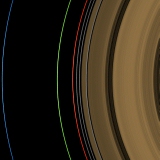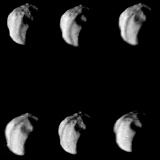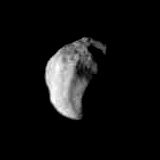 Voyager 2 view, across the rings, to Epimetheus. |
||
| EPIMETHEUS - MOON OF SATURN | ||
| Epimetheus (Greek for hindsight) was the son of Iapetus and Clymene and the brother of Prometheus (Greek for foresight) and Atlas. He is remembered for ignoring his brothers' warning to be careful of gifts from Zeus. According to legend, when he made Pandora his wife, he brought misfortune and sorrow upon the world. | ||
| Epimetheus was first seen by Walker in 1966. Walker is named as the co-discoverer of Epimetheus with Fountain and Larson who in 1977 showed that there were two satellites (Epimetheus and Janus) in very similar orbits. The configuration of the satellites was not absolutely clear until 1980 when Voyager 1 images were used to locate the two moons and enable a better understanding of their orbital properties. | ||
| Orbit | ||
| Epimetheus is co-orbital (sharing an orbit) with Janus. They orbit Saturn at a distance of about 151,472 kilometres and 151,422 kilometres, their orbits separated by just 50 kilometres. When the inner satellite approaches the outer satellite it gains orbital momentum which raises its orbit while slowing the outer satellite down. This causes the outer satellite to drop into a lower and faster orbit. The satellite formerly on the inner track becomes the outermost. This change-over appears to occur every four years and is thought to have resulted from the break-up of a single larger body. | ||
 Epimetheus orbits outside Saturn's bright rings. |
 The orbits of Pandora, Janus, Epimetheus, and Mimas. |
|
| Physical properties | ||
| Epimetheus has an irregular shape and measures 144 x 108 x 98 kilometres. It has, like most of Saturn's satellites, a very low density (600 kg m- 3). | ||
| Interior | ||
| Epimetheus' low density implies that it is probably very porous and has many large internal spaces or voids. | ||
| Magnetic field | ||
| No magnetic field has been detected. | ||
| Atmosphere | ||
| No atmosphere has been detected. | ||
| Surface | ||
| The surface is cross-cut by grooves. In one of the best Voyager images there is what appears to be a dark groove which runs around the middle of the satellite but it is in fact a shadow made by Saturn's F ring. | ||
| There are some large craters, about 20 to 30 kilometres in diameter, and lots of smaller more pristine craters which are about 5 kilometres across. The number of large worn down craters suggest that the surface is quite old. | ||
 Sequence showing the F ring shadow crossing Epimetheus. |
 Epimetheus's surface is crosscut by grooves. |
|
|
|
||